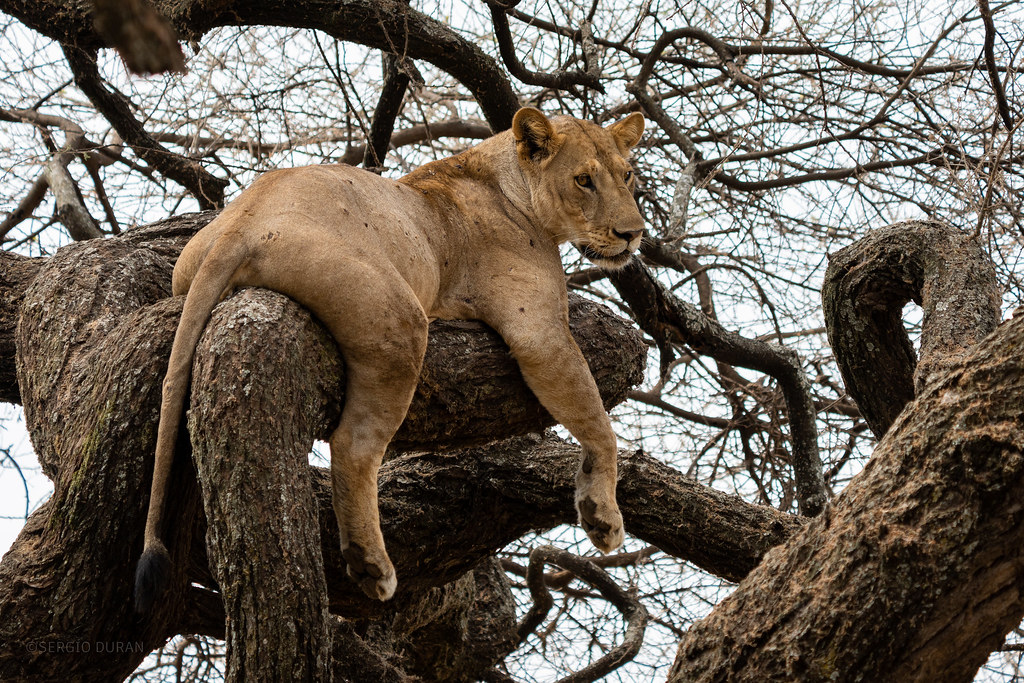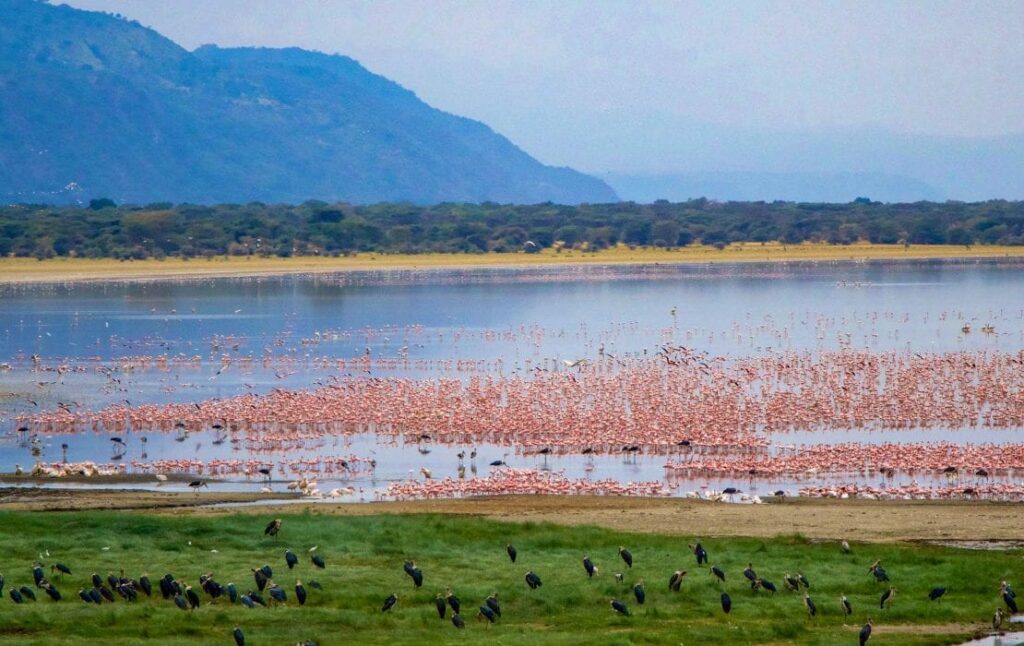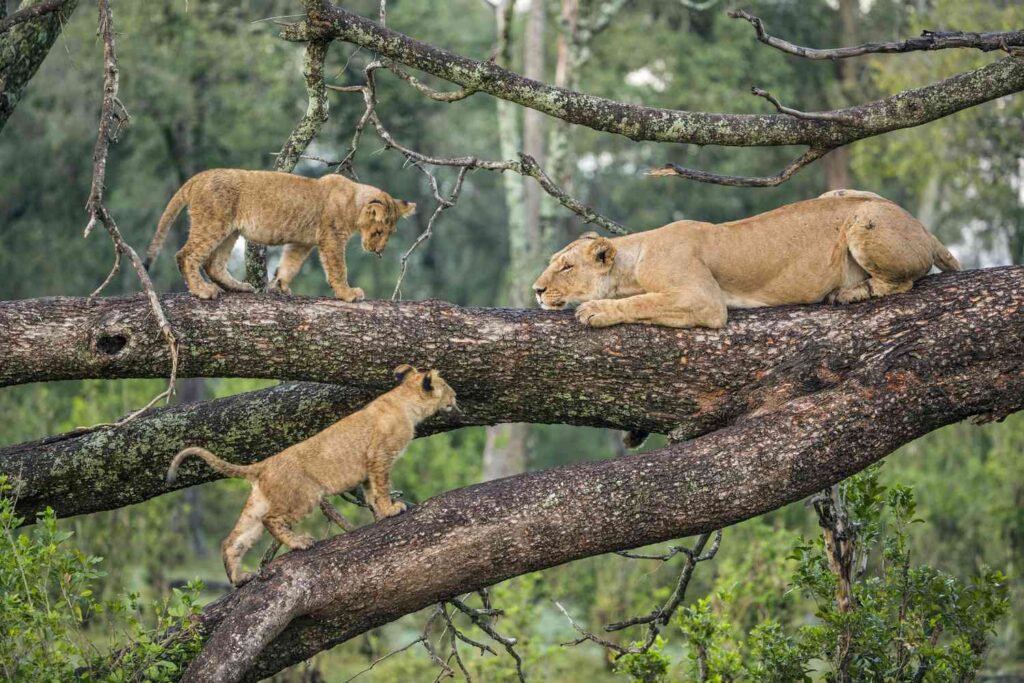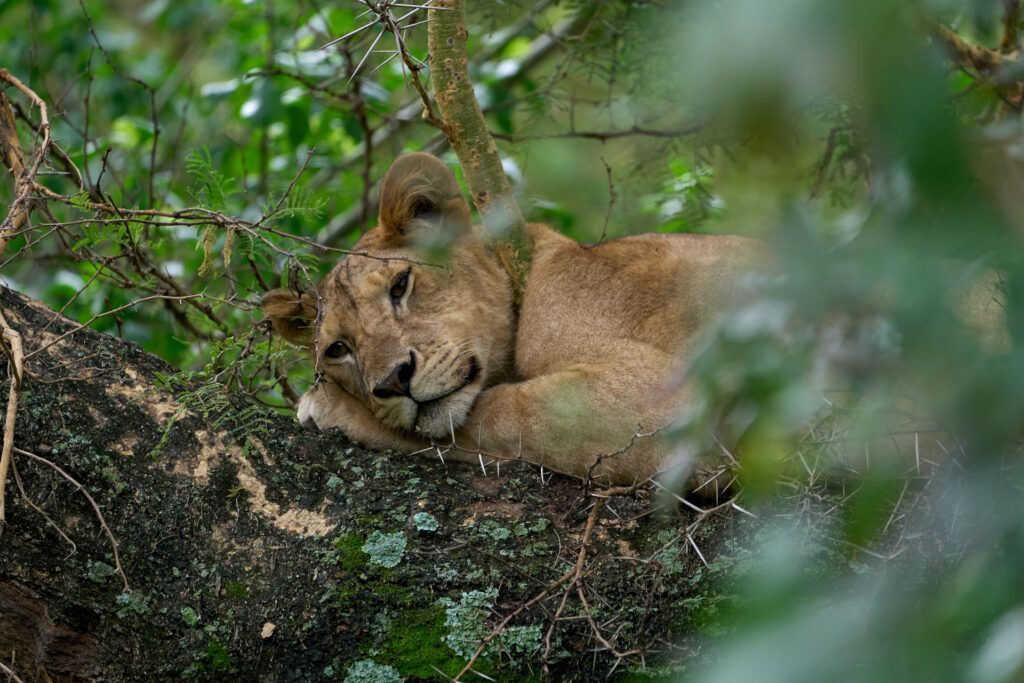Lake Manyara National Park
Lake Manyara National Park is one of the most remarkable national parks in Tanzania, renowned for its tree-climbing lions, which are not seen elsewhere in East Africa, except in the Ishasha sector of Queen Elizabeth National Park in Uganda. Lake Manyara National area boasts stunning vistas of the steep rift valley escarpment and the magnificent soda ash lake, often regarded as the most beautiful lake in Africa by numerous visitors to the area. It is among the premier safari spots in Tanzania.
Lake Manyara National Park derives its name from a shrub called “Emanyara,” a term from the Maasai language. In English, this plant is known as Euphorbia tirucalli, which the Maasai mostly utilize to demarcate their boundaries. The park was founded in 1960.

Lake Manyara National Park encompasses an area of 386 square kilometers, while the lake itself spans 262 square kilometers. It was designated as a Man and Biosphere Reserve in 1981. The park is around 100 kilometers from Arusha in northern Tanzania.
Lake Manyara National Park features two observation sites where tourists can exit their vehicles and stand on elevated platforms to appreciate the breathtaking expanse of the park and its nature. From the Hippo pool viewpoint, one may observe the rift valley wall, wildlife such as buffalo and zebras, waterfalls, and expansive terrain.
The alternative viewpoint is Lake Manyara viewpoint, offering breathtaking panoramas, a native lake populated by flamingos, the rift valley escarpment, and the terrestrial forest. Preparing for a vacation to Tanzania? A multitude of activities can be undertaken on a safari at Lake Manyara National Park, as outlined below;
Things to Do in Lake Manyara National Park
Wildlife observation:
In addition to its magnificent panoramic vistas, the park is home to various creatures, including the renowned tree-climbing lions unique to this Tanzanian park, as well as giraffes, elephants, zebras, wildebeests, impalas, klipspringers, baboons, and numerous others. Night game drives may be conducted with an armed tourist ranger; individuals interested in participating should always make reservations in advance.
Bird observation:
Lake Manyara National Park features many avian species and birdwatching locations, such as groundwater forests, and is home to over 350 bird species. Anticipate the presence of several avian species, including flamingos, storks, cormorants, herons, egrets, pink-backed pelicans, glossy ibises, sacred ibises, white-faced whistling ducks, fulvous whistling ducks, long-crested eagles, grey-crowned cranes, and spoonbills, among others. Birdwatching can be conducted at lakes, woodlands, and forests. The forest species include the crested guinea fowl, the boisterous silver-cheeked hornbill, and the crowned eagle, among others. The optimal period for birdwatching is from November to July.
Canoeing
Lake Manyara is an enchanting body of water, characterized by silver salt deposits that enable it to fluctuate with the seasons. Canoeing on this splendid lake reveals the grandeur of the steep escarpment adorned with lush forests, as well as a diverse array of aquatic birds and the picturesque woodlands along the shores. This action often occurs from 7 AM to 5 PM East African Time.
Camping:
Camping at Lake Manyara is available at five campgrounds, comprising three private and two public. Visitors wishing to participate in this activity are urged to bring their own camping equipment. The public campsites are equipped with washrooms, toilets, and water for cooking.
Guided Nature Walks :
Guided nature walks can be conducted along various routes inside the park, including the canopy walkway and the Majimoto boardwalk. This pathway will immerse guests in nature, showcasing abundant birdlife, a lake, diverse flora, and excellent photographic opportunities.
Picnics:
For tourists interested in picnicking, Lake Manyara National Park offers three well-established picnic sites equipped with well-maintained bathrooms and toilets. Visitors can enjoy a day tour from these sites with a packed lunch, which feature dining arrangements and provide excellent views of nature and wildlife.
Best time to visit Lake Manyara National Park
Optimal period for visiting Lake Manyara National Park. The optimal period to visit Lake Manyara National Park is from late June to October, coinciding with the dry season, although animal observation is favorable year-round. Nonetheless, Lake Manyara National Park is a picturesque destination, particularly during the wet season from November to May, when the verdant flora and waterfalls provide breathtaking vistas.
Lake Manyara National Park is regarded as a year-round safari destination in Tanzania; nonetheless, the dry season remains the optimal time to visit. Lake Manyara National Park is a hidden treasure located in northern Tanzania and is one of the few sites within the northern safari circuit of the country. The further northern safari circuits encompass Serengeti National Park, Ngorongoro Conservation Area, and Lake Manyara National Park, each providing genuine and unforgettable Tanzania safari experiences.
Lake Manyara National Park exhibits consistent weather, characterized by two primary seasons: the dry season and the wet season, each offering distinct advantages and rewards for both travelers and the park’s animals.
The Dry Season in Lake Manyara National Park
Lake Manyara National Park experiences the dry season from June to October. The dry season coincides with the peak travel season; so, crowds may be encountered in the park, although not to the extent observed in Serengeti National Park. The brief dry season of Lake Manyara National Park occurs in January and February, while the extended dry season spans from June to October. In the dry season, fauna in Lake Manyara National Park congregate at the limited waterholes, facilitating the simultaneous observation of diverse wildlife, while predators swiftly approach to hunt the oblivious animals as they drink or bathe. The sparse vegetation facilitates animal observation.
Despite being a dry season, temperatures tend to decrease, particularly in the mornings and evenings. Travelers are hence urged to bring warm attire. For budget-conscious travelers, the dry season is not the optimal time to visit Lake Manyara National Park, as lodging rates are significantly elevated due to increased demand.
The Rainy Seasons at Lake Manyara National Park
The rainy season at Lake Manyara National Park occurs from November to May, with the heaviest rainfall and longest durations of precipitation occurring in March and April. Despite the challenging terrain, Lake Manyara National area remains a picturesque destination even in the wet season, as the area flourishes with new vegetation and vibrant greenery, enhancing the beauty of photography.
Budget-conscious travelers seeking safaris in Lake Manyara National area can consider visiting during the wet season, when hotel costs are reduced and the area has decreased visitor density, thereby offering a degree of quiet. Visitors to Lake Manyara National area for birding safaris are additionally rewarded during the wet season, as numerous migrating birds arrive in the area, particularly between November and April.
The short rains at Lake Manyara National Park occur from November to December, during which temperatures typically rise significantly. The prolonged rains occur from March to April, typically rendering roadways difficult to navigate. The rainy season is, nonetheless, the optimal period to visit Lake Manyara National Park for budget safaris, as the majority of lodges and camps offer reduced rates.
Lake Manyara National Park is accessible year-round; however, optimal wildlife viewing occurs from June to October, while the ideal timeframe for birdwatching extends from November to July. Lake Manyara National Park is accessible by both road and air.
How to get to Lake Manyara National Park
Via Air Transport
The most efficient method to reach Lake Manyara National Park is via traveling into Kilimanjaro International Airport (KIA).This airport is situated approximately 46 kilometers from Arusha.It is feasible to travel to Arusha Airport (ARK) via a domestic flight departing from Julius Nyerere International Airport (DAR) in Dar es Salaam.
Alternatively, you may take an international flight to Julius Nyerere International Airport in Dar es Salaam and subsequently board a connecting aircraft from either Kilimanjaro International Airport (JRO) or Arusha Airport (ARK). Charter flights to Lake Manyara Airport (LKY) are available from the Serengeti or Arusha. You can access the park gate via road, located around 16 km away, which takes about 30 minutes to drive.
Domestic flights may be coordinated with a national airline. Moreover, charter flights between parks are typically arranged by your tour operator as an integral component of your safari package.
Approaching the destination
Via Road
Situated southwest of Arusha, Lake Manyara National Park is 126 km (78 miles) from Arusha and is readily accessible by automobile. Access is also flexible from Bahati, the capital of the Manyara area. This is the predominant mode of transportation utilized by tourists visiting the park along the northern safari circuit.
One can embark on a road safari by car along the freshly paved route from Arusha, which takes around 1.5 to 2 hours to reach the entrance gate. Given that Manyara Park is en route to the more illustrious Ngorongoro Crater and Serengeti National Park, which are additional parks within the northern circuit. Self Drive in Tanzania is a dependable organization.
If you lack private transportation, you may utilize public transport, such as a bus, to Mto wa Mbu village and subsequently hire a vehicle to access the park. The distance between Tarangire National Park and Lake Manyara National Park is 37.4 kilometers.
Where to stay in Lake Manyara National Park
Accommodation at Lake Manyara National Park ranges from camping to opulent hotels that offer exclusive comfort and exquisite cuisine; the choice of lodging will depend on the guests’ preferences and budget. Among the lodes are Lake Manyara Kilimamoja Lodge, Escarpment Luxury Lodge, Isoitok Camp, Morona Hill Lodge, Haven Nature Safari Camp, and Pamziko Safari Lodge and Spa, among others.



